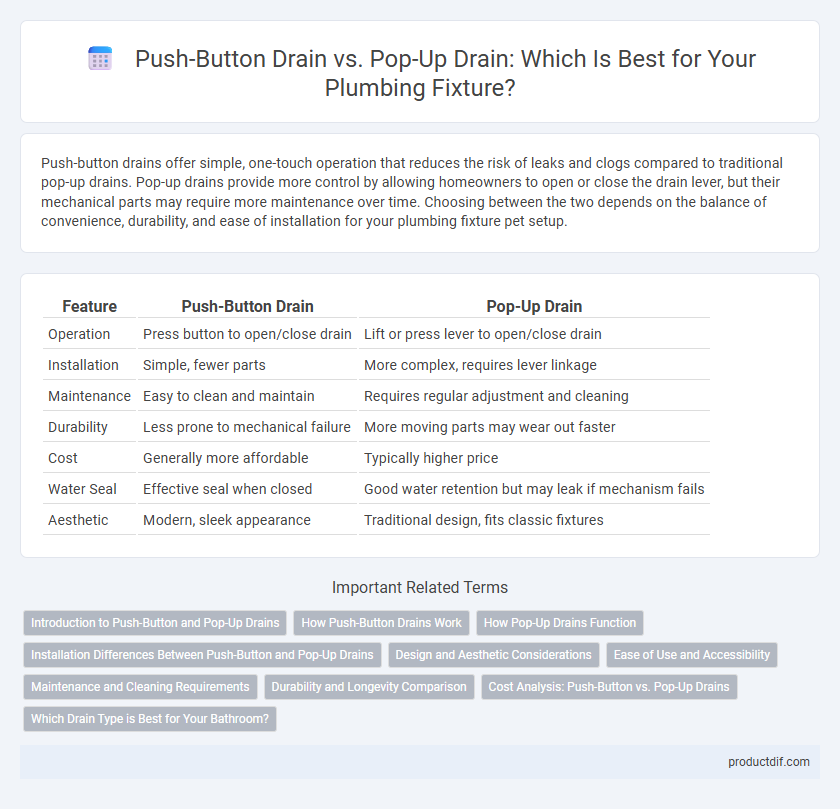Push-button drains offer simple, one-touch operation that reduces the risk of leaks and clogs compared to traditional pop-up drains. Pop-up drains provide more control by allowing homeowners to open or close the drain lever, but their mechanical parts may require more maintenance over time. Choosing between the two depends on the balance of convenience, durability, and ease of installation for your plumbing fixture pet setup.
Table of Comparison
| Feature | Push-Button Drain | Pop-Up Drain |
|---|---|---|
| Operation | Press button to open/close drain | Lift or press lever to open/close drain |
| Installation | Simple, fewer parts | More complex, requires lever linkage |
| Maintenance | Easy to clean and maintain | Requires regular adjustment and cleaning |
| Durability | Less prone to mechanical failure | More moving parts may wear out faster |
| Cost | Generally more affordable | Typically higher price |
| Water Seal | Effective seal when closed | Good water retention but may leak if mechanism fails |
| Aesthetic | Modern, sleek appearance | Traditional design, fits classic fixtures |
Introduction to Push-Button and Pop-Up Drains
Push-button drains feature a simple push mechanism that opens and closes the drain, ideal for contemporary sinks requiring minimalist design and easy operation. Pop-up drains operate with a lever or rod, offering customizable control over water flow and commonly found in bathroom sinks with traditional or classic styles. Both options provide effective water drainage but differ in installation complexity and user interaction, influencing choice based on bathroom aesthetics and functionality preferences.
How Push-Button Drains Work
Push-button drains operate through a simple mechanical mechanism that engages when the user presses the button, causing the drain stopper to seal or release water flow. These drains feature an internal spring-loaded stopper that clicks into place, offering a convenient one-touch control for opening and closing the basin. Unlike pop-up drains, push-button drains require no lever or external rod, making them ideal for sleek and minimalist sink designs.
How Pop-Up Drains Function
Pop-up drains operate through a lever or rod mechanism connected to the faucet or countertop, allowing users to open or close the drain by lifting or pressing a handle. When activated, the pop-up stopper moves vertically within the drain body, creating a seal to hold water or releasing it freely to drain. This design offers convenient control over water retention without manually manipulating the drain plug.
Installation Differences Between Push-Button and Pop-Up Drains
Push-button drains require a straightforward installation process involving a simple push mechanism that fits directly into the sink drain hole without additional linkage assembly. Pop-up drains demand a more complex installation, including connecting a pivot rod and lift assembly that controls the drain stopper's up and down movement. The push-button drain's minimal components reduce installation time and potential leak points compared to the intricate setup of pop-up drains.
Design and Aesthetic Considerations
Push-button drains offer a sleek, minimalist design with a flat, streamlined button that integrates seamlessly into modern sink styles, providing a clean aesthetic. Pop-up drains feature a visible lever or rod mechanism that can complement traditional or transitional bathroom designs, adding a functional decorative touch. Choosing between push-button and pop-up drains depends on the desired visual impact and compatibility with the overall bathroom fixture style.
Ease of Use and Accessibility
Push-button drains offer straightforward operation with a simple press mechanism, making them highly accessible for users with limited hand dexterity. Pop-up drains involve a lever or knob mechanism, which may require more effort and coordination, potentially challenging for individuals with mobility difficulties. Both types provide efficient drainage control, but push-button drains are generally preferred for ease of use and accessibility.
Maintenance and Cleaning Requirements
Push-button drains offer a simple mechanism with fewer crevices, making them easier to clean and less prone to clogging compared to pop-up drains. Pop-up drains require regular maintenance to prevent buildup around the moving parts and often need disassembly for thorough cleaning. Both drain types benefit from routine inspection, but push-button drains generally reduce the frequency of maintenance due to their streamlined design.
Durability and Longevity Comparison
Push-button drains feature a simple mechanical design that reduces wear and tear, resulting in enhanced durability compared to pop-up drains, which often contain multiple moving parts prone to corrosion and breakdown. Materials commonly used in push-button drains, such as brass and stainless steel, contribute to their longer lifespan by resisting rust and mineral buildup. In contrast, pop-up drains require regular maintenance to prevent leaks and mechanical failures, impacting their overall longevity.
Cost Analysis: Push-Button vs. Pop-Up Drains
Push-button drains typically cost between $20 and $50, making them a budget-friendly option compared to pop-up drains, which range from $30 to $100 depending on material and design. Installation for push-button drains is often simpler and quicker, potentially reducing labor costs by 20-30% compared to pop-up drains that require more complex mechanisms. When evaluating long-term maintenance, push-button drains may incur fewer repair expenses due to fewer moving parts, while pop-up drains can require occasional adjustments or replacements, impacting overall cost efficiency.
Which Drain Type is Best for Your Bathroom?
Choosing between a push-button drain and a pop-up drain depends on functionality and maintenance preferences; push-button drains offer one-touch operation with a sleek design, ideal for modern bathrooms, while pop-up drains provide traditional lever control and easier access for cleaning. Push-button drains tend to have fewer moving parts, reducing potential clogs, whereas pop-up drains allow for better water flow adjustment and are compatible with most sink designs. Considering bathroom aesthetics, user convenience, and plumbing compatibility will help determine the best drain type for your specific needs.
push-button drain vs pop-up drain Infographic

 productdif.com
productdif.com